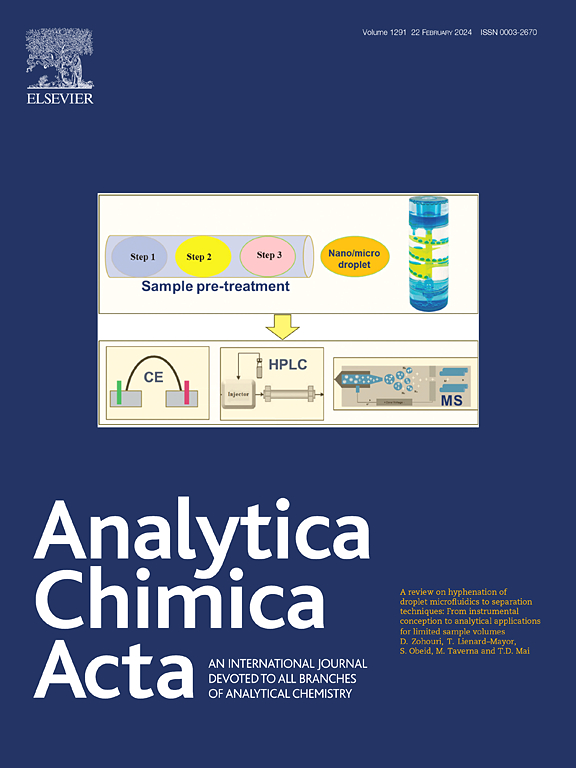Signal-on photoelectrochemical aptasensor for ultrasensitive zearalenone detection via cation exchange reaction amplification in COF-367 NSs/CdS QDs/Ag2S heterojunction
IF 5.7
2区 化学
Q1 CHEMISTRY, ANALYTICAL
引用次数: 0
Abstract
Background
Zearalenone (ZEN) is a non-steroidal estrogenic mycotoxin closely related to our health. It is of great significance to detect ZEN quickly and accurately in agricultural production. This study presents a novel signal-on photoelectrochemical (PEC) aptasensor for ultrasensitive detection of ZEN by integrating COF-367 nanosheets (NSs), CdS quantum dots (QDs), and Ag2S heterojunctions with cation exchange reaction (CER)-based signal amplification. The detection of ZEN was based on signal enhancement of COF-367 NSs/CdS QDs/Ag2S heterojunction and CER without any biological assembly, solving the problem of low abundance and false positives of signals.
Results
In this work, the COF-367 NSs/CdS QDs composite was synthesized via in-situ growth, demonstrating a 10-fold enhancement in photocurrent. The sensing strategy employs a hairpin aptamer structure stabilized by Ag+ ions. In the presence of ZEN, the hairpin structure unfolds, releasing Ag+ ions that trigger CER with COF-367 NSs/CdS QDs, forming the COF-367 NSs/CdS QDs/Ag2S heterostructure, which exhibits a hundredfold enhancement in PEC performance compared to individual components due to improved charge separation efficiency and light-harvesting capabilities. The amount of ZEN directly correlates with the quantity of released Ag+ ions, thereby determining the proportion of Ag2S in the composite. This multiplex release of Ag + ions also significantly enhances detection sensitivity. The sensor exhibits a strong linear relationship between photocurrent and the logarithmic concentration of ZEN over a wide range (5 pM–100 nM), with an exceptionally low detection limit of 1.1 pM (S/N = 3).
Significance and novelty
This strategy provides a highly sensitive, straightforward, versatile, and cost-effective method for trace analysis, eliminating the need for complex biological assembly. The results highlight the potential of this approach as a universal platform for high-performance PEC sensing and its applicability in rapid detection kits. This sensing strategy achieves multiple enhancements in photoelectrochemical signals without requiring complex assembly at sensing interface.

COF-367 NSs/CdS QDs/Ag2S异质结中阳离子交换反应扩增超灵敏玉米赤体烯酮检测的信号-光电适体传感器
玉米赤霉烯酮(ZEN)是一种与人体健康密切相关的非甾体类雌激素性真菌毒素。快速、准确地检测ZEN在农业生产中具有重要意义。本研究利用COF-367纳米片(NSs)、CdS量子点(QDs)和Ag2S异质结与基于阳离子交换反应(CER)的信号放大相结合,提出了一种用于ZEN超灵敏检测的新型信号光电化学(PEC)适体传感器。ZEN的检测基于COF-367 NSs/CdS QDs /Ag2S异质结和CER的信号增强,无需任何生物组装,解决了信号丰度低和假阳性的问题。结果原位生长法制备了COF-367 NSs/CdS量子点复合材料,光电流增强了10倍。传感策略采用由Ag+离子稳定的发夹适体结构。在ZEN的存在下,发夹结构展开,释放Ag+离子,触发COF-367 NSs/CdS量子点的CER,形成COF-367 NSs/CdS量子点/Ag2S异质结构,由于电荷分离效率和光收集能力的提高,与单个组分相比,其PEC性能提高了100倍。ZEN的用量与Ag+离子的释放量直接相关,从而决定了复合材料中Ag2S的比例。Ag+离子的多重释放也显著提高了检测灵敏度。该传感器在宽范围内(5 pM至100 nM)显示出光电流与ZEN的对数浓度之间的强线性关系,检测限极低,为1.1 pM (S/N = 3)。该策略为痕量分析提供了一种高度敏感、直接、通用和经济高效的方法,消除了复杂的生物组装的需要。结果突出了该方法作为高性能PEC传感的通用平台及其在快速检测试剂盒中的适用性的潜力。该传感策略实现了光电化学信号的多重增强,而不需要在传感界面上进行复杂的组装。
本文章由计算机程序翻译,如有差异,请以英文原文为准。
求助全文
约1分钟内获得全文
求助全文
来源期刊

Analytica Chimica Acta
化学-分析化学
CiteScore
10.40
自引率
6.50%
发文量
1081
审稿时长
38 days
期刊介绍:
Analytica Chimica Acta has an open access mirror journal Analytica Chimica Acta: X, sharing the same aims and scope, editorial team, submission system and rigorous peer review.
Analytica Chimica Acta provides a forum for the rapid publication of original research, and critical, comprehensive reviews dealing with all aspects of fundamental and applied modern analytical chemistry. The journal welcomes the submission of research papers which report studies concerning the development of new and significant analytical methodologies. In determining the suitability of submitted articles for publication, particular scrutiny will be placed on the degree of novelty and impact of the research and the extent to which it adds to the existing body of knowledge in analytical chemistry.
 求助内容:
求助内容: 应助结果提醒方式:
应助结果提醒方式:


